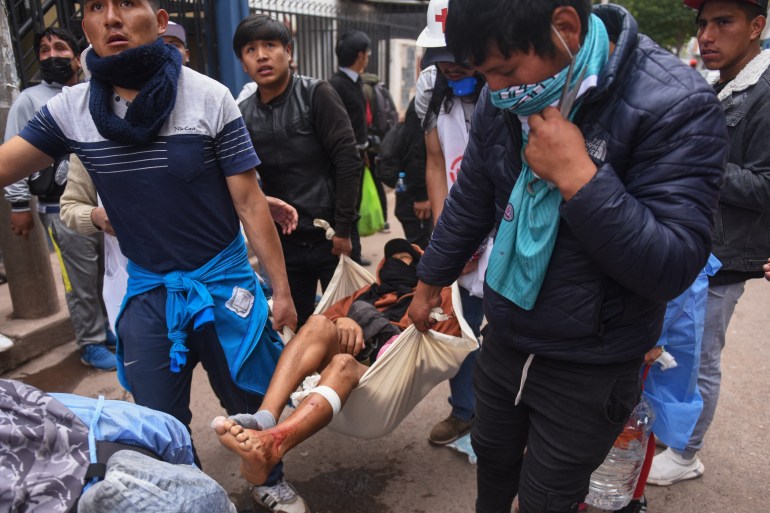Peru protests spread to Cusco, gateway city to Machu Picchu
At least 47 people have died in the violence, including 39 killed in clashes with police and an officer set on fire.
Clashes between protesters and police have broken out in Peru’s tourist city of Cusco as a month of demonstrations, which have now left at least 47 people dead, continued over the removal of the country’s ex-President Pedro Castillo.
Health officials in Cusco said 37 civilians and six police officers were injured on Wednesday when protesters tried to take over the city’s Alejandro Velasco Astete International Airport, a gateway for tourists to visit the nearby Incan citadel of Machu Picchu. One civilian later died after being hit by gunfire, officials said.
Video footage showed protesters throwing stones at police who fired tear gas to clear the area. People injured in the violence could be seen receiving assistance from medics and fellow protesters.
Cusco’s Crime Prevention Prosecutor Eduardo Poblete said the demonstrators wanted to emulate Monday’s protest in the southern city of Juliaca, near Lake Titicaca, where 17 people were killed in violence as thousands of protesters attempted to take the airport.
The violence is the worst the Andean country has seen in more than 20 years and was sparked by the abrupt removal of the left-wing Castillo in early December.
Protesters, mainly from neglected rural areas of the country still loyal to Castillo, are calling for the resignation of the new President, Dina Boluarte, quick general elections, a new Constitution, the release of Castillo, who was arrested for ”rebellion” after trying to illegally shutter Congress, and justice for the protesters killed in clashes with police.
Some of the worst protest violence came on Monday when 17 people were killed in clashes with police and protesters later attacked and burned a police officer to death.
In total, Peru’s Ombudsman’s Office said the death toll included 39 civilians killed in clashes, another seven who died in traffic accidents related to road blockades, and the police officer who was burned to death. Wednesday’s death Cusco increases the toll to 48.
Peru’s government has announced a three-day curfew from 8pm to 4am in Puno province, where Juliaca is located.

The National Prosecutor’s Office said on Tuesday that it had requested information from the Presidency of the Council of Ministers and Peru’s defence and interior ministries for an investigation it has opened against Boluarte and other members of her cabinet over the violent clashes.
Deep divisions in Peru
Castillo, a political novice who lived in a two-story adobe home in the Andean highlands before moving to the presidential palace, eked out a narrow victory in elections in 2021 that rocked Peru’s political establishment and laid bare the deep divisions between residents of the capital, Lima, and the long-neglected countryside.
Boluarte was Castillo’s former running mate before taking over the presidency. She has said she supports a plan to push up to 2024 elections for president and Congress originally scheduled for 2026. She’s also expressed support for judicial investigations into whether security forces acted with excessive force.
But such moves have so far failed to quell the unrest, which after a short respite around the Christmas and New Year’s holidays has resumed with force in some of Peru’s poorest areas.
The Armed Conflict Location & Event Data Project (ACLED), a non-governmental organisation tracking conflict globally, said violence in Peru had increased by 150 percent compared with the same month last year.
Over the past month, average weekly political violence events increased by 150% in #Peru relative to the weekly average for the preceding year.
— Armed Conflict Location & Event Data Project (@ACLEDINFO) January 12, 2023
In Juliaca, a crowd marched alongside the coffins of the 17 people killed in Monday’s protests.
“Dina killed me with bullets,” said a piece of paper attached to the coffin of Eberth Mamani Arqui, in a reference to Peru’s current president.
“This democracy is no longer a democracy,” chanted the relatives of the victims.
As they passed a police station guarded by dozens of officers, the marchers yelled: “Murderers!”
A delegation from the Inter-American Commission on Human Rights has started a fact-finding visit to Peru to look into the protests and the police response.



